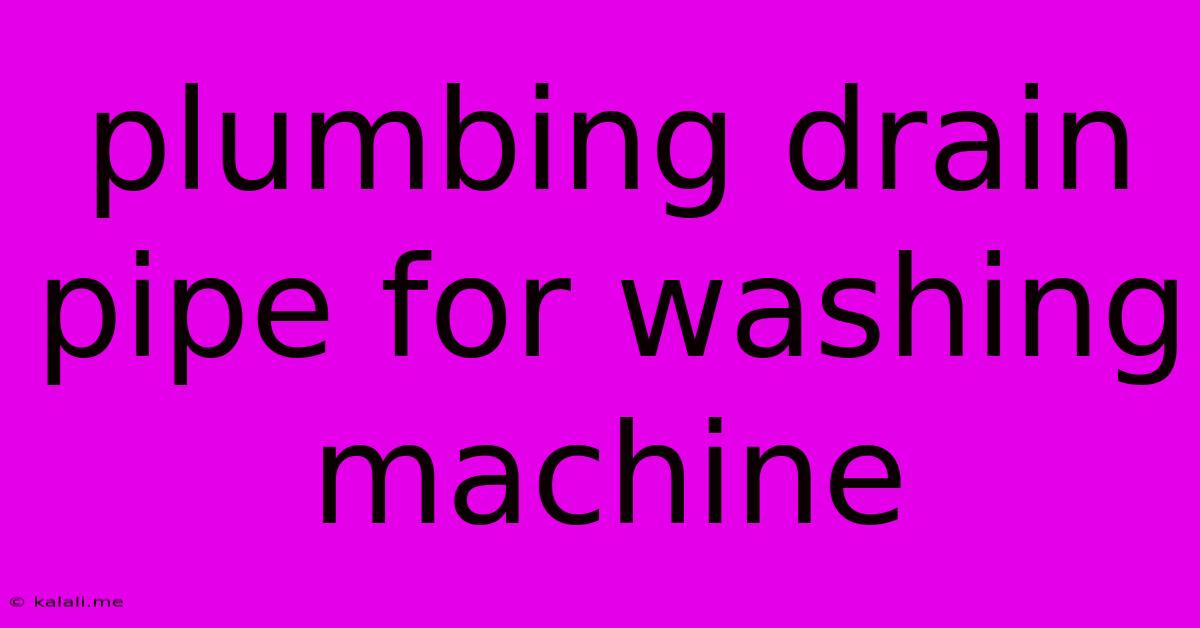Plumbing Drain Pipe For Washing Machine
Kalali
Jun 04, 2025 · 3 min read

Table of Contents
Choosing the Right Plumbing Drain Pipe for Your Washing Machine
This guide will help you understand the crucial aspects of selecting and installing the correct drain pipe for your washing machine. A properly installed drain prevents costly water damage and ensures the longevity of your appliance. Choosing the wrong pipe can lead to leaks, clogs, and inefficient drainage.
Understanding Washing Machine Drainage Requirements
Washing machines require a specific type of drain pipe to handle the volume and pressure of wastewater effectively. Ignoring these requirements can result in overflow, backups, and potentially damage your machine. Key factors to consider include:
- Pipe Diameter: Most washing machines require a drain pipe with a minimum diameter of 2 inches (5 cm). Using a smaller diameter pipe can restrict water flow and cause drainage issues. Check your washing machine's manual for the recommended diameter.
- Pipe Material: Common materials include PVC (polyvinyl chloride), ABS (acrylonitrile butadiene styrene), and flexible corrugated plastic. PVC and ABS are durable and relatively inexpensive, while flexible pipes offer greater installation flexibility, but may be less durable in the long run. Consider the accessibility and potential for movement in your drain location when choosing a material.
- Pipe Length and Height: The drain pipe needs to reach the appropriate height and avoid any low points that could trap water. The height requirement depends on the specific washing machine model – check your manufacturer's instructions. A drain that's too long can create siphoning issues.
- Air Gap: A crucial element for preventing wastewater from being siphoned back into your washing machine is the air gap. This is a short vertical section of pipe above the drain connection, ensuring a separation between the washing machine's drain and the drainpipe itself.
Installation Best Practices for a Washing Machine Drain Pipe
Proper installation is vital for preventing leaks and ensuring efficient drainage.
- Secure Connections: Use appropriate pipe fittings and ensure all connections are tight and secure. Apply pipe sealant to prevent leaks.
- Proper Slope: The drain pipe should have a slight slope (typically 1/4 inch per foot) to ensure gravity assists drainage. A level or improperly sloped pipe will lead to slow drainage and potential clogs.
- Support the Pipe: Use appropriate clamps or straps to support the drain pipe to prevent sagging or kinking.
- Access for Maintenance: Install the pipe in a location that allows for easy access to clear any clogs or perform maintenance as needed.
- Avoid Tight Bends: Sharp bends in the pipe can restrict water flow and increase the risk of clogs. Opt for smooth curves.
- High-Water Standpipe: Consider the height of your standpipe; it needs to be high enough to prevent siphoning, but not so high that it creates undue strain on your washing machine drain pump.
- Vent: While not always strictly necessary for short, straight drains, a proper vent can significantly improve the efficiency of the drainage system and help to prevent pressure buildup and odors.
Troubleshooting Common Washing Machine Drain Problems
- Slow Drainage: Check for clogs, kinks, or insufficient slope in the drain pipe.
- Leaking Drain: Inspect connections for leaks and tighten or reseal as needed.
- Siphoning: Ensure a proper air gap is installed between the washing machine drain and the drainpipe.
- Clogged Drain: Utilize a drain snake or plunger to clear any obstructions. If necessary, replace the drain pipe if severe blockage persists.
By following these guidelines, you can confidently select and install the appropriate plumbing drain pipe for your washing machine, ensuring efficient and trouble-free operation. Remember to consult your washing machine's manual for specific recommendations and always prioritize safety during installation. If you are uncomfortable undertaking this task yourself, it's always advisable to consult a qualified plumber.
Latest Posts
Latest Posts
-
How To See History Of Emails Used In Steam
Jun 06, 2025
-
Can The Steel Defender Use Magic Items
Jun 06, 2025
-
When Did Spider Man Join The Future Foundation
Jun 06, 2025
-
What Does A Flywheel Do In A Car
Jun 06, 2025
-
Low Cold Water Pressure In Kitchen Sink
Jun 06, 2025
Related Post
Thank you for visiting our website which covers about Plumbing Drain Pipe For Washing Machine . We hope the information provided has been useful to you. Feel free to contact us if you have any questions or need further assistance. See you next time and don't miss to bookmark.